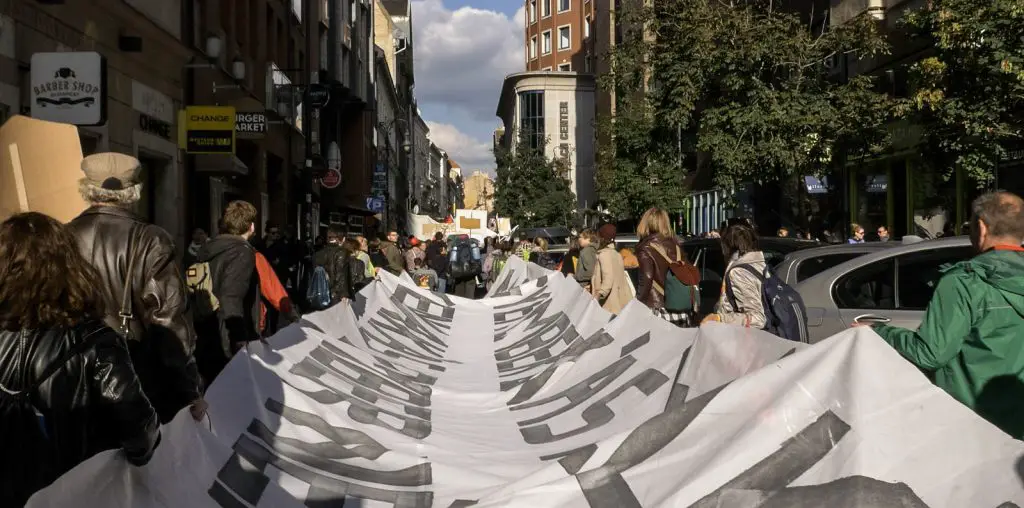
The title of Marcel Ophuls’ “The Troubles We’ve Seen: A History of Journalism in Wartime”is not entirely accurate: this is not a history lesson in the media coverage of war, per se, but is primarily a focus on how the media covered the Balkan internecine conflicts of the early 1990s, particularly the destruction of Sarajevo. While the title may be somewhat off, the film is brutally on target. Ophuls, clearly one of the great documentarians of modern cinema (“The Sorrow and the Pity,” “Hotel Terminus”) offers a profound and disturbing meditation of the role journalists play in funneling the horror of warfare to viewers and readers in distant and safe lands. It is an extraordinary achievement on every possible intellectual and emotional level.
“The Troubles We’ve Seen: A History of Journalism in Wartime” was made in 1994 (its American release was held up for years due to a long-simmering dispute which is mercifully settled). In a way, it is clearly dated (it is doubtful anyone eleven years ago would have predicted the rise of jingoistic news networks not only in America, but in the Arab world and even in the level of European coverage). But in its own way, “The Troubles We’ve Seen” comes across the Atlantic as a troubling time capsule which is opened to reveal both evergreen questions and a lethal reminder of how the media failed to jolt an immediate global political response to the tragedies in Sarajevo.
Ophuls, who is frequently on camera, engages in lengthy conversations with the press corps in Sarajevo during January 1993. There is a clear sense of division within the media: the traditional press (writers and still photographers) are scornful of the flash and vapidity of TV journalists. But the ultimate division is between the journalists and their subjects: the disconnect offers a startling lack of sympathy for the misery in the lives of the people of Sarajevo. The media only seem to become genuinely concerned when a press photographer is shot by a sniper; coverage of the killings of the elderly and the young don’t ring the same level of visceral emotion.
Not surprisingly, much of Ophuls’ focus is on the French media. He has no qualms about bashing the French TV news, and even a non-media figure (actor Philippe Noiret) makes an unexpected appearance to share barbed comments on the incestuous nature of how French TV news covered the administration of former President Francois Mitterand (Noiret notes that a few of the reporters at a presidential roundtable interview were married to government ministers, thus ensuring powder puff questions).
A few historic tangents are traveled, most contentiously in questioning Robert Capa’s famous picture of a Republican solider being killed in the Spanish Civil War. Legendary war correspondent (and former Mrs. Ernest Hemingway) Martha Gelhorn defends both Capa’s reputation and the role of women in combat journalism (yes, the old battle of the sexes in covering the battle between nations is raised). There is also a lengthy detour into discussing how the U.S. military choreographed and controlled press coverage of the 1991 Gulf War (even the normally cynical French bought into that, as shamefully propagandistic coverage from that conflict proves).
“The Troubles We’ve Seen: A History of Journalism in Wartime” unfurls at a leisurely pace, perhaps a bit too leisurely for those who prefer their journalism to be on the loud and fast side. Yet the slower pace allows for intelligent conversation among intelligent people. It is a film where people have something important and personal to relate, and Ophuls is not stingy in allowing them to voice their viewpoints with as much time and depth as required.
Pop culture also sneaks in via weird ways. Some of it is in questionable taste, particularly when clips from old movies (including “Duck Soup” and “His Girl Friday” are inserted). One sick joke juxtaposes an interview with a Bosnian actor whose legs were blown off in a Serbian attack with James Cagney tap-dancing up a storm in “Yankee Doodle Dandy.”
But the most ironic cultural reference is when a Bosnian surgeon, tired from treated the war wounded over working endless hours on limited supplies, breaks into a soft a capella version of the spiritual from which the title is derived: “Nobody Knows the Troubles I’ve Seen.” It is an ironic choice of music, and a pointed one: despite being present and capturing the fury of war on film or video or in words, the media is still just an observer. The real troubles are borne by those who are in the media’s viewfinder – that is, until the next big story breaks and everyone rushes off to cover it. By today’s ADD-worthy view of world events, Sarajevo of 1993 is as distant as Sarajevo of 1914. Can anyone reading this actually pause and recite both the causes of that conflict and the names of the major players on all sides of the issue? For those who do remember that war, the quality of coverage was strong – but the unwillingness of American and European leaders to forcefully respond to the slaughter showed that political authority could ignore powerful news coverage.
“The Troubles We’ve Seen: A History of Journalism in Wartime” is a provocative landmark in filmmaking. In view of current events, it did not arrive 11 years too late. It is actually the most timely movie in theaters today.
